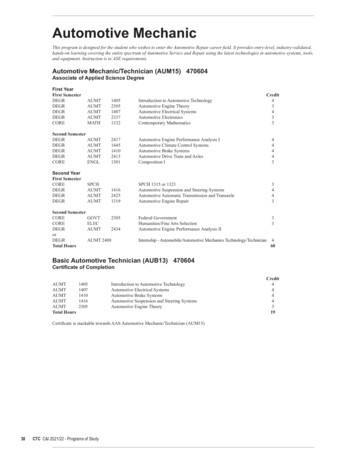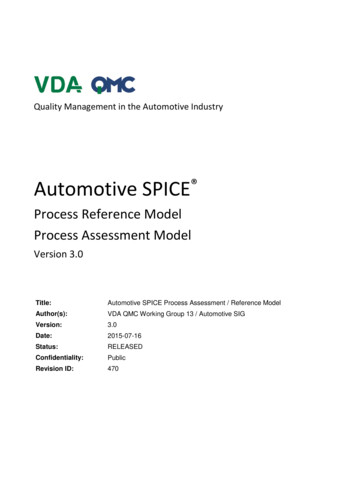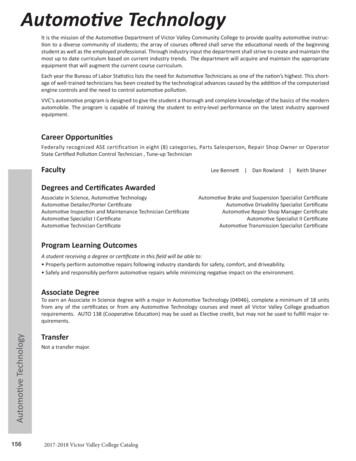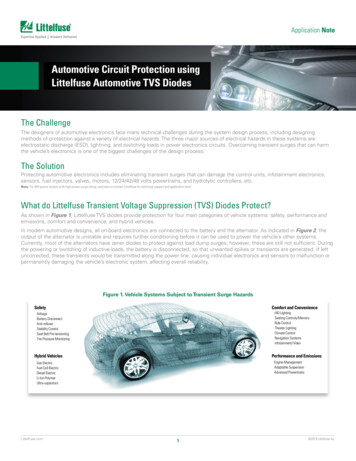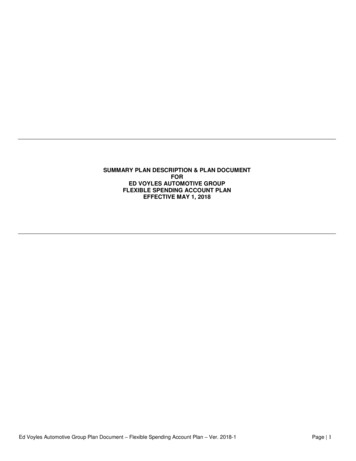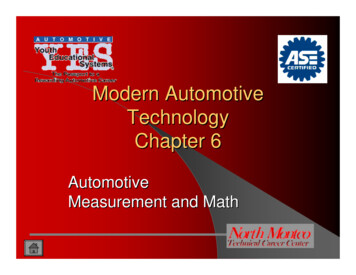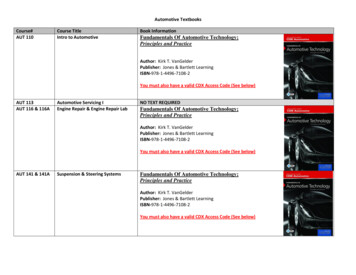
Transcription
ACCELERATING AUTOMOTIVE SOFTWARE SAFETY WITH MISRA AND STATIC ANALYSISACCELERATING AUTOMOTIVE SOFTWARESAFETY WITH MISRA AND STATIC ANALYSISTRUSTED LEADERS OF SOFTWARE ASSURANCE AND ADVANCED CYBER-SECURITY SOLUTIONSWWW.GRAMMATECH.COM1TECHNICAL WHITEPAPER
ACCELERATING AUTOMOTIVE SOFTWARE SAFETY WITH MISRA AND STATIC ANALYSISINTRODUCTIONThe MISRA C/C coding guidelines came about due to concern for safely using C and C incritical automotive systems. Since its inception in 1998, MISRA has become one of the most usedcoding standards in the automotive industry and has spread to other safety-critical devices in medical and industrial control. Static analysis tools are needed to properly use and enforce the standard, but not all tools are created equal. Sophisticated static analysis tools that provide support forthe complex development process and perform more than simple syntax checking are desired inorder to reduce risk, costs, and time to market.SUPPORTING THE DEVELOPMENT PROCESSStatic analysis tools support multiple aspects of the software development process, from earlycode development to post-launch debugging and forensics. Our whitepaper Making Safety-CriticalSoftware Development Affordable with Static Analysis describes this in more detail. The recurringtheme is that static analysis plays a critical role in improving software quality, enforcing safe codingstandards such as MISRA, and detecting defects and security vulnerabilities that are difficult to findduring testing.MISRA plays an important role in C/C development when applied to safety-critical automotivesoftware. Enforcement of the standard is difficult to do manually, so static analysis is used to enforce the standard. It is important to note, though, that there is a significant difference betweenadvanced static analysis that supports MISRA rule checking and simpler tools that perform rulechecking alone. GrammaTech’s CodeSonar is capable of supporting MISRA coding enforcementbut also providing valuable error detection and security vulnerability analysis that goes above andbeyond simple code syntax checking.CodeSonar is integrated with software development tools such as Jira, Bugzilla, Lattix Architect,Eclipse, etc. These integrations allow seamless adoption of static analysis into an existing development process. Source code quality and standards compliance can be checked right at thedeveloper’s desktop before checking into the build system. Defects and vulnerabilities can beautomatically assigned for review and remediation. Audits can be done at any time and resultsdistributed to the development team.IMPROVING SAFETY WITH MISRA AND STATIC ANALYSISThe MISRA guidelines themselves acknowledge the importance of tools in successfully using theguidelines:2TECHNICAL WHITEPAPER
ACCELERATING AUTOMOTIVE SOFTWARE SAFETY WITH MISRA AND STATIC ANALYSIS in its favour as a language is the fact that C is very mature, and consequentlywell-analysed and tried in practice. Therefore its deficiencies are known and understood. Also there is a large amount of tool support available commercially which canbe used to statically check the C source code and warn the developer of the presenceof many of the problematic aspects of the language.[MISRA-C:2004 Guidelines for the use of the C language in critical systems]MISRA guidelines define a safer subset of C or C that should prevent many classes of errors.Following these guidelines does improve code quality and, in combination with modern development tools, rigorous testing and good software development practices should improve systemsafety as well (assuming the level of rigour remains the same throughout hardware and systemdevelopment.) However, no coding standard is perfect and enforcing the rules isn’t enough, by itself, to ensure better software safety. Moreover, without tool support (as acknowledged by MISRA’sauthors) the standard doesn’t stand on its own.To really understand why static analysis is crucial in producing safety-critical software for automotive applications, we need to first look at how defects get into programs, and second, how thesedefects are found and fixed. Defects are an unfortunate but unavoidable side effect of writing code.Research has shown that software developers introduce defects at an average rate of one defectper ten lines of code. Most development time is spent finding and fixing those defects.But by the time the code is released, most commercial software will still have about one defectper 1,000 lines of code (KLOC). Open-source code is a little better, at 0.68/KLOC. Cleanroomsoftware, which combines formal methods of requirements and design with statistical usage testing, was found to have 0.1/KLOC. Considering that the software content of today’s luxury car iswell above 100 million lines of code, even in the absolute best-case scenario, there would still beat least 10,000 latent software defects and, in practice, there are likely more than 100,000. Thedefects that remain in the software are typically difficult to detect in testing, and can result in poorinteroperability with other subsystems or unchecked interfaces, unexpected behavior, or outrightfailure.Finding and fixing defects during testing is extremely time consuming. When a tester finds an erroror a failure, the root cause is in many cases unknown, forcing the developer to trace the problemback to source. This means that the circumstances that created the failure must be reproduced,and the developer must study and understand the related code. The reality is that many bugs cannot be reproduced on demand and are never fixed.The power of static analysis is that it doesn’t rely on test cases to find problems, nor does it require that an error or failure be reproduced. An advanced static analysis tool can infer the runtimebehavior of a program without actually running the program. Furthermore, when it identifies aproblem, it also pinpoints the locations within the code that created the failure. This makes the jobof debugging far simpler. Static analysis does not eliminate the need for testing altogether, but it3TECHNICAL WHITEPAPER
ACCELERATING AUTOMOTIVE SOFTWARE SAFETY WITH MISRA AND STATIC ANALYSIScomplements testing activities, providing an additional and critical validation technique. The realityis that in large and complex software systems, there are so many possible states, and such an astronomical number of possible paths of execution, that it is infeasible to exhaustively test them all.Static analysis, on the other hand, can explore these paths and state conditions in the aggregate,and is able to find problems that are missed by testing.DETECTING ERRORS THAT CODING STANDARDS AND TESTING MISSESA key contribution that advanced static analysis tools like CodeSonar provide to safety-criticalsoftware development is the ability to find defects that have slipped through the traditional development techniques. As evidenced by high profile cases in the automotive industry, safety issuesthat make it to market and on the road are expensive to fix – orders of magnitude more expensivethan during development. Additionally, critical defects can be detected early, even early enough tobe caught during coding. Some examples of classes of defects that can be missed during development, even when good engineering practices, MISRA coding, and rigorous testing is done, aregiven below. Concurrency defects often occur randomly and only after a system has been integratedcompletely on the final hardware platform. Unlike other testing, GrammaTech’s CodeSonarcan reason about multithreaded/multitasking code behaviour and detect dead locks, raceconditions, and other types of concurrency errors. Security vulnerabilities are software defects that can be exploited to interfere with a system’s behavior or expose critical data. Security is often overlooked in systems where safety isparamount. Advanced static analysis tools can detect security vulnerabilities that arise frommalformed or tainted data outside expected values. Tainted data analysis helps to trace input data in the system to its use in the application andwarn of any potential security vulnerabilities that arise. In today’s hostile operating environment, it’s foolhardy to assume that system input data is well-formed. Detecting these types ofsecurity issues is very difficult when data is passed across many functions. Automated analysiscan provide the full control and data path for tainted data, which allows for rapid remediation. Complex inter-procedural defects are difficult to detect, especially with unit and subsystemtesting. CodeSonar does advanced inter-function (procedure) analysis of control and data flowof the entire scope of the program. Deep analysis decreases the rate of false positives (errorsthat are false) but also increases the rate of true positives (errors that are verified true). CodeSonar’s analysis extends into executables, object files, and libraries. Binary analysis provides insight and error detection of compiled code as object files, libraries,and even executables. A unique capability of CodeSonar is that it performs the same detailedanalysis on binary code as it does on source. This can include system and third-party librariesthat are provided without source code. Developers can ensure that the all code (both binaryand source) is up to the quality standard required for the project.4TECHNICAL WHITEPAPER
ACCELERATING AUTOMOTIVE SOFTWARE SAFETY WITH MISRA AND STATIC ANALYSISMISRA RULE COVERAGEWhen developers are required to adhere to coding standards, they look for a tool that can helpthem find violations. One of the metrics they use to compare tools is the coverage (the proportionof rules that the tools claim to check), with a naïve strategy being to choose the tool that claimsthe highest coverage.Unfortunately, the notion of coverage is not well-defined, and because there is no reliable source ofinformation that can be used to compare coverage between tools, customers must trust vendorsto reasonably interpret the term, and to report their coverage fairly.SOME COVERAGE IS EASYSome MISRA rules are simple enough that a straightforward code-syntax-checker can find allviolations with no false positives. For such rules, coverage is easy—the tool can either find violations or not, with no ground in-between. In MISRA C 2012, such rules are labeled Decidable. Ifthe violation can be detected by looking only at one compilation unit, the rule is also labeled SingleTranslation Unit. For example, rule 4.2 forbids the use of Trigraphs, and is labeled this way. Claimingcoverage for this rule is believable and provable.Less clear, however, is if a violation can only be reliably found if the tool needs to look at multiplecompilation units at the same time (these are labeled System in the standard). For example, MISRAC 2012 rule 5.1’s “External identifiers should be distinct” is certainly decidable, but the only way atool can reliably find a violation is if it examines all compilation units and compares all such identifiers found in each.If a tool claims to have full coverage of a rule with System scope, then it is only reasonable to believe that the tool is also capable of finding all the compilation units that contribute to the program.Over-approximation and under-approximation of the set can lead to both false positives and falsenegatives. Humans routinely get this wrong, so a user of a tool that does not offer an automaticway to determine the set is running the risk of getting incorrect results.The most effective tool is one that integrates tightly with the build system, as that is most often themost trustworthy source.UNDECIDABILITYIn MISRA C 2012, some rules are labeled “Undecidable,” meaning that it is fundamentally impossible to have a method that can, in general, say for sure if a violation is present or not. Because ofthis property, the author of a checker must find a sweet spot that balances the risk of false positiveswith the risk of false negatives. Most of these rules require an analysis that is capable of reasoningabout the execution of the program, so only the most sophisticated static analysis tools can beexpected to do a good job. A good example is MISRA C 2012 rule 17.2, which forbids recursion,both direct and indirect (i.e., calls through function pointers).5TECHNICAL WHITEPAPER
ACCELERATING AUTOMOTIVE SOFTWARE SAFETY WITH MISRA AND STATIC ANALYSISThe trouble is, claims of coverage are often made that ignore whether a tool is good or bad atfinding violations. If a tool can only find the most obvious and superficial instances of violations, is itreasonable for it to claim that it has coverage of that rule? The other side of that coin is interestingto consider too — if a tool finds all violations, but also reports so many false positives that is impractical to inspect them all, is it fair to say that it has coverage?COVERAGE BREADTHThe final aspect of rule coverage that makes it complicated is that coding standards are usuallyquite loosely defined, whereas static analysis tools must have a precise definition of the propertiesthat they are looking for. Consequently, it is common for a checker to detect a property that is eithera superset or a subset of what the rule requires.For example, let’s consider CodeSonar’s coverage of MISRA C 2012 Rule 2.2: “There shall be nodead code.” For the purposes of this rule, dead code is code that is executed, but whose removalcannot affect program behavior. CodeSonar has an Unused Value checker, which finds placeswhere a variable is assigned a value that is never subsequently used. All such places violate theMISRA rule, but there are other ways in which the rule can be violated that are not detected by thischecker. Thus, the Unused Value checker covers only a subset of what the rule specifies, and otherCodeSonar checkers fill in the gaps.In some cases, the rule and the checker are not in a strict subset/superset relationship. They mayoverlap a lot or a little, or the checker may detect a property that is not a direct violation but is verylikely to lead to a violation of the rule.In CodeSonar, the policy is to claim coverage only if there is a large overlap between what therule specifies and what our checker will find, and where the checker does not yield warnings thatwould be reasonably judged to be false positives for that rule (notwithstanding that they may betrue positives otherwise).MISRA C 2012, RULE 1.3There is one MISRA C 2012 rule in particular for which the issue of claimed versus real coverage isacute. One should be wary of a static analysis tool claiming coverage of MISRA C 2012 Rule 1.3:“There shall be no occurrence of undefined or critical unspecified behavior.” This rule is so broadthat an additional 10-page Appendix in the standard outlines possible scenarios to avoid. This inturn references the C standards: those for C90/99 enumerate 230 instances of undefined behavior(65 of these are not covered by any other MISRA rule), and 51 instances of critical unspecifiedbehavior (of which 17 are not covered by any other MISRA rule). Furthermore, the rationale forDirective 4.1 adds: “the presence of a run-time error indicates a violation of Rule 1.3.”Consequently, Rule 1.3 specifies an enormous amount of forbidden behavior, including null pointerdereferences, buffer overruns, use of uninitialized memory, data races, use after free errors, andmany of the other hazards of programming in C.6TECHNICAL WHITEPAPER
ACCELERATING AUTOMOTIVE SOFTWARE SAFETY WITH MISRA AND STATIC ANALYSISThe problems with rule coverage claims should be clear — although this one rule (of the 143 in thestandard) constitutes only 0.7% of the standard, it covers maybe 50% of the truly unpleasant kindsof failures that can befall a C program.Furthermore, if a tool is to claim coverage of Rule 1.3, it should have checkers that have a goodsized intersection with all of those undesirable behaviors. If a tool can only find a tiny percentageof them, then it is unreasonable for it to claim coverage. In contrast, advanced static analysis toolssuch as CodeSonar are explicitly designed to find the kinds of run-time errors that constitute violations of Rule 1.3. Analyses that make it possible for them to find such defects with reasonable precision must be whole-program, path-sensitive, aware of hazardous information-flows, and capableof reasoning about concurrently-executing threads.ACCELERATING TIME TO CERTIFICATIONObvious advantages of static analysis tools include risk-reduction and time-reduction from findingand fixing defects and vulnerabilities in early stages of development. The cost savings of findingcritical defects is significant compared to finding and fixing these bugs in system integration orworse, when products are in service. Additionally, CodeSonar provides automated documentationto support testing and quality/robustness evidence. Much of the manpower used in safety certifications is documentation and evidence production. Automation, and specifically static analysis,reduces this burden significantly. As a TUV SUD certified ISO 26262 tool, CodeSonar provides assurances to developers that it can be integrated into a safety-critical development project withoutfurther certification requirements – something that adds costs and risk otherwise.CONCLUSIONThe tools needed to support successful safety-critical projects require more than simple sourceanalysis and MISRA rule checking. Enterprise-level development projects require sophisticatedtools that support and enhance the development lifecycle, including integrating with other development automation tools. The ability to go beyond MISRA rule enforcement and prevent criticaldefects and vulnerabilities from leaking through the development process pays big dividends incost and risk reduction.7TECHNICAL WHITEPAPER
ACCELERATING AUTOMOTIVE SOFTWARE SAFETY WITH MISRA AND STATIC ANALYSISREFERENCESGuidelines for the Use of the C Language in Critical Systems, ISBN 978-1-906400-10-1 (paperback), ISBN 978-1-906400-11-8 (PDF), March 2013.“Making Safety-Critical Software Development Affordable with Static Analysis”, GrammaTechwhitepaper, 2016.“Advanced Driver Assistance Systems (ADAS), Safety, and Static Analysis”, GrammaTech whitepaper, 2016“Reduce Automotive Software Failures with Static Analysis”, GrammaTech whitepaper, 2015“How to Avoid Common Pitfalls in MISRA Compliance”, GrammaTech whitepaper, 2014GrammaTech, Inc. is a leading developer of software-assurance tools and advanced cybersecurity solutions. GrammaTech helps organizations develop and release high quality software,free of harmful defects that cause system failures, enable data breaches, and increase corporateliabilities in today’s connected world. GrammaTech’s CodeSonar is used by embedded developers worldwide.CodeSonar and CodeSurfer are registered trademarks of GrammaTech, Inc. 2016 GrammaTech, Inc. All rights reserved.8TECHNICAL WHITEPAPER
An advanced static analysis tool can infer the runtime behavior of a program without actually running the program. Furthermore, when it identifies a problem, it also pinpoints the locations within the code that created the failure. This makes the job of debugging far simpler. Static analysis does not eliminate the need for testing altogether .



